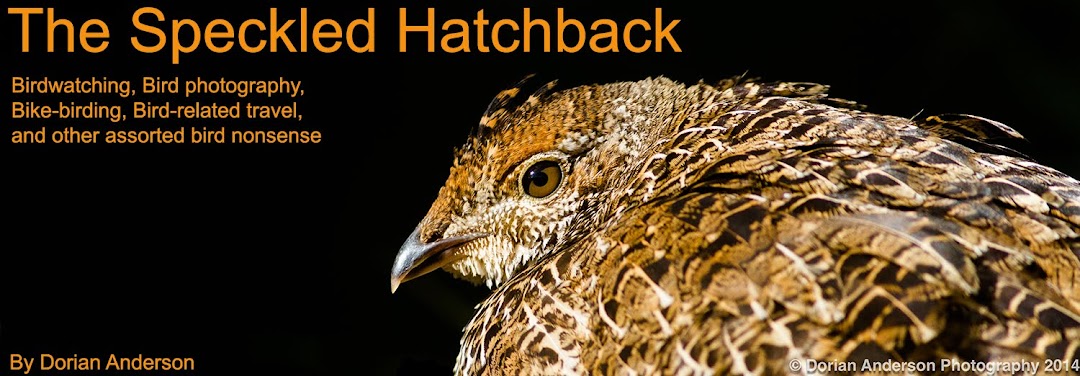Birding Spain
11 Little Bustards flew into the field just after the photo!
11 Little Bustards flew into the field just after the photo!
Almost unbelievably, there isn't a single direct flight from Los Angeles to Madrid, so I was forced to connect in Dallas to an overnight flight to my final destination. However, my flight out of LAX was delayed by more than 2 hours due to weather, and I missed my connecting flight (I know, a weather delay in SoCal, right?!!?). The path of least resistance was to accept a seat on the same flight the following night and kill the intervening day in Dallas. I sure as hell wasn't happy about losing a day in Spain, but I didn't really have any other option.
With ~20 hours kill in Texas, I rented a car at the airport, and, the following morning, set of for some suburban birding at Lewisville Lake Environmental Learning Area (LLELA). I chose that particular spot so that I could have a late lunch with a childhood friend before returning to the airport. En route to that locale, I hit a local supermarket to grab a few snacks to get me through the morning. I ended up with two bananas and a box of granola bars. Upon removing the first of the granola bars from the box, this is what I found.
For those that might not be able to read the tiny text, it says, "Chewy Challenge #7: Go bird watching. How many different birds can you find?" I found it an all-too-appropriate way to begin my day of birding in Dallas. I have since dispatched the following note to Quaker customer service.
Dear Quaker
My name is Dorian Anderson, and I am a life-long fan of your Chewey Granola bars. I am also a life-long bird watcher. This past week, I was stranded in Dallas for 24 hours as I missed a connecting flight to Spain where I was to spend the next 10 days - you guessed it - bird watching. With a day to kill before my rescheduled flight, I decided to do some bird watching around Dallas. En route to Lewisville Lake Environmental Learning Area (LLELA, http://llela.unt.edu/), I purchased a box of your tasty Quaker Chewy peanut butter chocolate chip granola bars. I removed the first bar from the box and appropriately found a note on the wrapper that stated, "Chewy Challenge #7: Go bird watching. How many different birds can you find?".
Well, in the following 4 hours I found exactly 60 species of birds at LLELA (http://ebird.org/ebird/view/checklist/S34513258). Beyond touting my love for your product, this note is to serve as a request that Quaker donate $300 ($5/species) to LLELA for my completion of the stated bird watching challenge. LLELA does much environmental education, and I think any additional funds that the park/organization receives would be helpful in inspiring future generations of bird lovers and outdoor enthusiasts.
I have also posted a copy of this letter on my very popular bird watching and bird photography blog, The Speckled Hatchback (http://thespeckledhatchback.blogspot.com). The blog is widely read by both American and foreign birdwatchers. It was because of the successes of this blog that I was invited to Spain as a guest of the Extremadura Tourism Board, a region of Spain with wonderful birdlife that is looking to increase its visibility in the American birding community.
Yes, I understand this is all a bit strange, but, at the end of it all, I'm only asking Quaker to help an organization with which I have zero connection. Doing so would be a great gesture on your part and would certainly warrant a follow-up post on my blog that further touts your products as a tasty, healthy snack for birders and other persons on the go.
Thank you so much for your consideration of this matter. I look forward to your response.
Dorian Anderson, Ph.D.
Birder, Photographer, Writer, Blogger, Lecturer
http://thespeckledhatchback.blogspot.com
www.dorianandersonphotography.com
thespeckledhatchback@gmail.com
Now we wait. Sure, I missed my flight and lost a day in Spain, but, with the help of birding, I still managed to find something positive in the entire experience. That's the beauty of birding. It's always there for you no matter what else goes wrong.
Oh yeah, if anyone else feel particularly motivated to follow up with Quaker and prod them about my donation request, you can use this link and copy and paste the below message into your comment to them. You never know, right? It'll take 2 minutes and could make for a great story if they actually follow through!
Dear Quaker
This note is to serve as follow up note to that from Dorian Anderson regarding a $300 donation to the Lewisville Lake Environmental Learning Area. I fully support his request and hope that Quaker is able to help the center provide outdoor education for young school children moving forward.
Sincerely
(Your name here)
***Click images for higher resolution views***
Loads more at my Instragram Account
Whimbrel
Los Angeles County, California
Canon 400mm f/4 IS DO II on EOS 1D Mark IV
1/5000 at f/5.6, ISO 800, handheld
1/5000 at f/5.6, ISO 800, handheld













